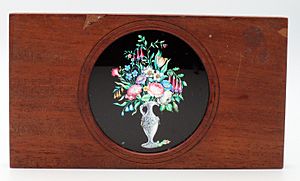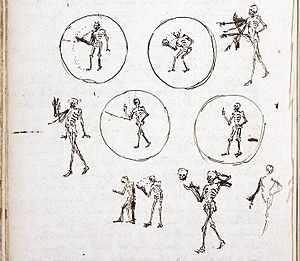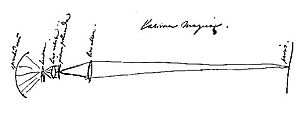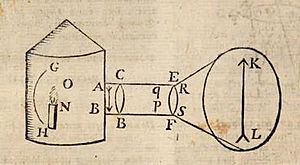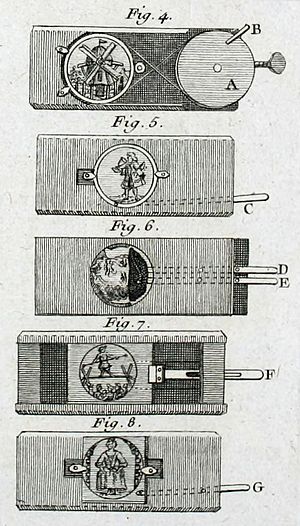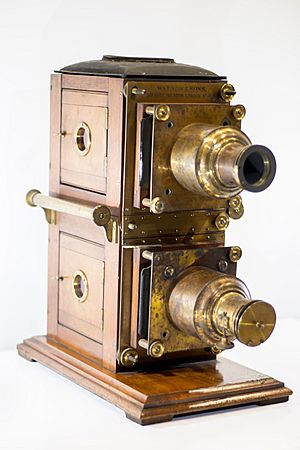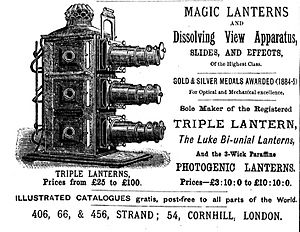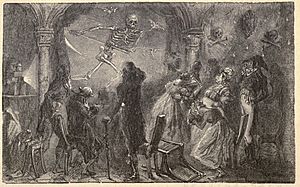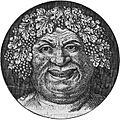Magic lantern facts for kids
The magic lantern, also known by its Latin name lanterna magica, is an early type of image projector that used pictures—paintings, prints, or photographs—on transparent plates (usually made of glass), one or more lenses, and a light source. It was mostly developed in the 17th century and commonly used for entertainment purposes. It was increasingly used for education during the 19th century. Since the late 19th century, smaller versions were also mass-produced as toys. The magic lantern was in wide use from the 18th century until the mid-20th century when it was superseded by a compact version that could hold many 35 mm photographic slides: the slide projector.
Contents
Technology
Apparatus

The magic lantern used a concave mirror in back of a light source to direct the light through a small rectangular sheet of glass—a "lantern slide" that bore the image—and onward into a lens at the front of the apparatus. The lens adjusted to focus the plane of the slide at the distance of the projection screen, which could be simply a white wall, and it therefore formed an enlarged image of the slide on the screen. Some lanterns, including those of Christiaan Huygens and Jan van Musschenbroek, used 3 lenses for the objective.
Biunial lanterns, with two objectives, became common during the 19th century and enabled a smooth and easy change of pictures. Stereopticons added more powerful light sources to optimize the projection of photographic slides.
Slides
Originally the pictures were hand painted on glass slides. Initially, figures were rendered with black paint but soon transparent colors were also used. Sometimes the painting was done on oiled paper. Usually black paint was used as a background to block superfluous light, so the figures could be projected without distracting borders or frames. Many slides were finished with a layer of transparent lacquer, but in a later period cover glasses were also used to protect the painted layer. Most handmade slides were mounted in wood frames with a round or square opening for the picture.
After 1820 the manufacturing of hand colored printed slides started, often making use of decalcomania transfers. Many manufactured slides were produced on strips of glass with several pictures on them and rimmed with a strip of glued paper.
The first photographic lantern slides, called hyalotypes, were invented by the German-born brothers Ernst Wilhelm (William) and Friedrich (Frederick) Langenheim in 1848 in Philadelphia and patented in 1850.
Light sources
Apart from sunlight, the only light sources available at the time of invention in the 17th century were candles and oil lamps, which were very inefficient and produced very dim projected images. The invention of the Argand lamp in the 1790s helped to make the images brighter. The invention of limelight in the 1820s made them very much brighter. The invention of the intensely bright electric arc lamp in the 1860s eliminated the need for combustible gases or hazardous chemicals, and eventually the incandescent electric lamp further improved safety and convenience, although not brightness.
Precursors
Several types of projection systems existed before the invention of the magic lantern. Giovanni Fontana, Leonardo Da Vinci and Cornelis Drebbel described or drew image projectors that had similarities to the magic lantern.
In the 17th century, there was an immense interest in optics. The telescope and microscope were invented (in 1608 and the 1620s respectively) and apart from being useful to some scientists, such instruments were especially popular as entertaining curiosities to people who could afford them. The magic lantern would prove a perfect successor.
Camera obscura
The magic lantern can be seen as a further development of camera obscura. This is a natural phenomenon that occurs when an image of a scene at the other side of a screen (for instance a wall) is projected through a small hole in that screen as an inverted image (left to right and upside down) on a surface opposite to the opening. It was known at least since the 5th century BC and experimented with in darkened rooms at least since circa 1000 AD. The use of a lens in the hole has been traced back to circa 1550. The portable camera obscura box with a lens was developed in the 17th century. Dutch inventor Cornelis Drebbel is thought to have sold one to Dutch poet, composer and diplomat Constantijn Huygens in 1622, while the oldest known clear description of a box-type camera is in German Jesuit scientist Gaspar Schott's 1657 book Magia universalis naturæ et artis.
Steganographic mirror
The 1645 first edition of German Jesuit scholar Athanasius Kircher's book Ars Magna Lucis et Umbrae included a description of his invention, the "Steganographic Mirror": a primitive projection system with a focusing lens and text or pictures painted on a concave mirror reflecting sunlight, mostly intended for long-distance communication. He saw limitations in the increase of size and diminished clarity over a long distance and expressed his hope that someone would find a method to improve on this.
In 1654, Belgian Jesuit mathematician André Tacquet used Kircher's technique to show the journey from China to Belgium of Italian Jesuit missionary Martino Martini. Some reports say that Martini lectured throughout Europe with a magic lantern, which he might have imported from China, but there's no evidence that it used anything other than Kircher's technique. However, Tacquet was a correspondent and friend of Christiaan Huygens and may thus have been a very early adapter of the magic lantern technique that Huygens developed around this period.
Invention
Christiaan Huygens
Prominent Dutch scientist Christiaan Huygens, is nowadays widely accepted as the true inventor of the magic lantern. He knew Athanasius Kircher's 1645 edition of Ars Magna Lucis et Umbrae which described a primitive projection system with a focusing lens and text or pictures painted on a concave mirror reflecting sunlight. Christiaan's father Constantijn had been acquainted with Cornelis Drebbel who used some unidentified optical techniques to transform himself and to summon wonderful appearances in magical performances. Constantijn Huygens wrote very enthusiastically about a camera obscura device that he got from Drebbel in 1622.
The oldest known document concerning the magic lantern is a page on which Christiaan Huygens made ten small sketches of a skeleton taking off its skull, above which he wrote "for representations by means of convex glasses with the lamp" (translated from French). As this page was found between documents dated in 1659, it is believed to have been made in the same year. Huygens soon seemed to regret this invention, as he thought it was too frivolous. In a 1662 letter to his brother Lodewijk he claimed he thought of it as some old "bagatelle" and seemed convinced that it would harm the family's reputation if people found out the lantern came from him. Christiaan had reluctantly sent a lantern to their father, but when he realized that Constantijn intended to show the lantern to the court of King Louis XIV of France at the Louvre, Christiaan asked Lodewijk to sabotage the lantern.
Christiaan initially referred to the magic lantern as "la lampe" and "la lanterne", but in the last years of his life he used the then common term "laterna magica" in some notes. In 1694, he drew the principle of a "laterna magica" with two lenses.
Walgensten, the Dane
Thomas Rasmussen Walgensten (c. 1627 – 1681), a mathematician from Gotland, studied at the university of Leyden in 1657–58. He possibly met Christiaan Huygens during this time (and/or on several other occasions) and may have learned about the magic lantern from him. Correspondence between them is known from 1667. At least from 1664 until 1670, Walgensten demonstrated the magic lantern in Paris (1664), Lyon (1665), Rome (1665-66), and Copenhagen (1670). He "sold such lanterns to different Italian princes in such an amount that they now are almost everyday items in Rome" according to Athanasius Kircher in 1671. In 1670, Walgensten projected an image of Death at the court of King Frederick III of Denmark. This scared some courtiers, but the king dismissed their cowardice and requested to repeat the figure three times. The king died a few days later. After Walgensten died, his widow sold his lanterns to the Danish Royal collection, but they have not been preserved. Walgensten is credited with coining the term "Laterna Magica", assuming he communicated this name to Claude Dechales who, in 1674, published about the machine of the "erudite Dane" that he had seen in 1665 in Lyon.
Possible German origins: Wiesel and Griendel
There are many gaps and uncertainties in the magic lantern's recorded history. A separate early magic lantern tradition seems to have been developed in southern Germany and includes lanterns with horizontal cylindrical bodies, while Walgensten's lantern and probably Huygens' both had vertical bodies. This tradition dates at least to 1671, with the arrival of instrument maker Johann Franz Griendel in the city of Nürnberg, which Johann Zahn identified as one of the centers of magic lantern production in 1686. Griendel was indicated as the inventor of the magic lantern by Johann Christoph Kohlhans in a 1677 publication. It has been suggested that this tradition is older and that instrument maker Johann Wiesel (1583–1662) from Augsburg may have been making magic lanterns earlier on and possibly inspired Griendel and even Huygens. Huygens is known to have studied samples of Wiesel's lens-making and instruments since 1653. Wiesel did make a ship's lantern around 1640 that has much in common with the magic lantern design that Griendel would later apply: a horizontal cylindrical body with a rosette chimney on top, a concave mirror behind a fixture for a candle or lamp inside and a biconvex lens at the front. There is no evidence that Wiesel actually ever made a magic lantern, but in 1674, his successor offered a variety of magic lanterns from the same workshop. This successor is thought to have only continued producing Wiesel's designs after his death in 1662, without adding anything new.
Moving images
The magic lantern was not only a direct ancestor of the motion picture projector as a means for visual storytelling, but it could itself be used to project moving images.
Some suggestion of movement could be achieved by alternating between pictures of different phases of a motion, but most magic lantern "animations" used two glass slides projected together - one with the stationary part of the picture and the other with the part that could be set in motion by hand or by a simple mechanism.
Motion in animated slides was mostly limited to either two phases of a movement or transformation, or a more gradual singular movement (e.g. a train passing through a landscape). These limitations made subjects with repetitive movements popular, like the sails on a windmill turning around or children on a seesaw. Movements could be repeated over and over and could be performed at different speeds.
A common technique that is comparable to the effect of a panning camera makes use of a long slide that is simply pulled slowly through the lantern and usually shows a landscape, sometimes with several phases of a story within the continuous backdrop.
Movement of projected images was also possible by moving the magic lantern itself. This became a staple technique in phantasmagoria shows in the late 18th century, often with the lantern sliding on rails or riding on small wheels and hidden from the view of the audience behind the projection screen.
Various types of mechanical slides
Various types of mechanisms were commonly used to add movement to the projected image:
- slipping slides: a movable glass plate with one or more figures (or any part of a picture for which movement was desired) was slipped over a stationary one, directly by hand or with a small drawbar (see: Fig. 7 on the illustration by Petrus van Musschenbroek: a tightrope walker sliding across the rope). A common example showed a creature that could move the pupils in its eyes, as if looking in all directions. A long piece of glass could show a procession of figures, or a train with several wagons. Quite convincing illusions of moving waves on a sea or lake have also been achieved with this method.
- slipping slides with masking: black paint on portions of the moving plate would mask parts of the underlying image - with a black background - on the stationary glass. This made it possible to hide and then reveal the previous position of a part, for instance a limb, to suggest repetitious movement. The suggested movement would be rather jerky and usually operated quickly. Masking in slides was also often used to create change rather than movement (see: Fig. 6 on the illustration by Petrus van Musschenbroek: a man, his wig and his hat): for instance a person's head could be replaced with that of an animal. More gradual and natural movement was also possible; for instance to make a nose grow very long by slowly moving a masking glass.
- lever slides: the moving part was operated by a lever. These could show a more natural movement than slipping slides and were mostly used for repetitive movements, for instance a woodcutter raising and lowering his axe, or a girl on a swing. (see: Fig. 5 on the illustration by Petrus van Musschenbroek: a drinking man raising and lowering his glass + Fig. 8: a lady curtsying)
- pulley slides: a pulley rotates the moving part and could for instance be used to turn the sails on a windmill (see: fig. 4 on illustration by Van Musschenbroek)
- rack and pinion slides: turning the handle of a rackwork would rotate or lift the moving part and could for instance be used to turn the sails on a windmill or for having a hot air balloon take off and descend. A more complex astronomical rackwork slide showed the planets and their satellites orbiting around the sun.
- fantoccini slides: jointed figures set in motion by levers, thin rods, or cams and worm wheels. A popular version had a somersaulting monkey with arms attached to mechanism that made it tumble with dangling feet. Named after the Italian word for animated puppets, like marionettes or jumping jacks. Two different British patents for slides with moving jointed figures were granted in 1891.
- a snow effect slide can add snow to another slide (preferably of a winter scene) by moving a flexible loop of material pierced with tiny holes in front of one of the lenses of a double or triple lantern.
Mechanical slides with abstract special effects include:
- the Chromatrope: a slide that produces dazzling colorful geometrical patterns by rotating two painted glass discs in opposite directions, originally with a double pulley mechanism but later usually with a rackwork mechanism. It was possibly invented around 1844 by English glass painter and showman Henry Langdon Childe and soon added as a novelty to the program of the Royal Polytechnic Institution.
- the Astrometeoroscope or Astrometroscope: a large slide that projected a lacework of dots forming constantly changing geometrical line patterns, compared with stars and meteors. It was invented in or before 1858 by the Hungarian engineer S. Pilcher and used a very ingenious mechanism with two metal plates obliquely crossed with slits that moved to and fro in contrary directions. Except for when the only known example was used in a performance, it was kept locked away at the Polytechnic so no one could discover the secret technique. When the Polytechnic auctioned the device, Picher eventually paid an extravagant price for his own invention to keep is workings secret.
- the Eidotrope: counter-rotating discs of perforated metal or card (or wire gauze or lace), producing swirling Moiré patterns of bright white dots. It was invented by English scientist Charles Wheatstone in 1866.
- the Kaleidotrope: a slide with a single perforated metal or cardboard disc suspended on a spiral spring. The holes can be tinted with colored pieces of gelatin. When struck the disc's vibration and rotation sends the colored dots of light swirling around in all sorts of shapes and patterns. The device was demonstrated at the Royal Polytechnic Institution around 1870 and dubbed "Kaleidotrope" when commercial versions were marketed.
- the Cycloidotrope (circa 1865): a slide with an adjustable stylus bar for drawing geometric patterns on sooty glass when hand cranked during projection. The patterns are similar to that produced with a Spirograph.
- a Newton colour wheel slide that, when spinning fast enough, blends seven colours into a white circle
Dissolving views
The effect of a gradual transition from one image to another, known as a dissolve in modern filmmaking, became the basis of a popular type of magic lantern show in England in the 19th century. Typical dissolving views showed landscapes dissolving from day to night or from summer to winter. This was achieved by aligning the projection of two matching images and slowly diminishing the first image while introducing the second image. The subject and the effect of magic lantern dissolving views is similar to the popular Diorama theatre paintings that originated in Paris in 1822. 19th century magic lantern broadsides often used the terms dissolving view, dioramic view, or simply diorama interchangeably.
The effect was reportedly invented by phantasmagoria pioneer Paul de Philipsthal while in Ireland in 1803 or 1804. He thought of using two lanterns to make the spirit of Samuel appear out of a mist in his representation of the Witch of Endor. While working out the desired effect, he got the idea of using the technique with landscapes. An 1812 newspaper about a London performance indicates that De Philipsthal presented what was possibly a relatively early incarnation of a dissolving views show, describing it as a "a series of landscapes (in imitation of moonlight), which insensibly change to various scenes producing a very magical effect.”
Another possible inventor is Henry Langdon Childe, who purportedly once worked for De Philipsthal. He is said to have invented the dissolving views in 1807, and to have improved and completed the technique in 1818. The oldest known use of the term "dissolving views" occurs on playbills for Childe's shows at the Adelphi Theatre in London in 1837. Childe further popularized the dissolving views at the Royal Polytechnic Institution in the early 1840s.
Despite later reports about the early invention, and apart from De Philipsthal's 1812 performance, no reports of dissolving view shows before the 1820s are known. Some cases may involve confusion with the Diorama or similar media. In 1826, Scottish magician and ventriloquist M. Henry introduced what he described as "beautiful dissolvent scenes," "imperceptibly changing views," "dissolvent views," and "Magic Views"—created "by Machinery invented by M. Henry." In 1827, Henry Langdon Childe presented "Scenic Views, showing the various effects of light and shade," with a series of subjects that became classics for the dissolving views. In December 1827, De Philipsthal returned with a show that included "various splendid views (...) transforming themselves imperceptibly (as if it were by Magic) from one form into another."
Biunial lanterns, with two projecting optical sets in one apparatus, were produced to more easily project dissolving views. Possibly the first horizontal biunial lantern, dubbed the "Biscenascope" was made by the optician Mr. Clarke and presented at the Royal Adelaide Gallery in London on December 5, 1840. The earliest known illustration of a vertical biunial lantern, probably provided by E.G. Wood, appeared in the Horne & Thornthwaite catalogue in 1857. Later on triple lanterns enabled additional effects, for instance the effect of snow falling while a green landscape dissolves into a snowy winter version.
A mechanical device could be fitted on the magic lantern, which locked up a diaphragm on the first slide slowly whilst a diaphragm on a second slide opened simultaneously.
Philip Carpenter's copper-plate printing process, introduced in 1823, may have made it much easier to create duplicate slides with printed outlines that could then be colored differently to create dissolving view slides. However, all early dissolving view slides seem to have been hand-painted.
Experiments
There have been many different experiments involving sorts of movement with the magic lantern. These include:
- galvanometer slide: a flattened coil with a magnetized needle moving from side to side when a battery is connected.
- projection of moving frog legs, with the nerves and muscles of severed frog legs connected to electric wires.
- hour-glass projection: the projection of a flattened hourglass showed the sand flowing upwards. Extreme magnification made the effect extra impressive, with the grains of sand forming a wave-like pattern.
- cohesion figure projection of liquids: different oils and fats create many kinds of moving patterns when manipulated between clear glass plates or a narrow glass box.
Several of these experiments were publicly demonstrated at the Royal Polytechnic Institution.
Choreutoscope and phenakistiscope-type systems
Versions of the magic lantern were used to project transparent variations of the phénakisticope. These were adapted with a mechanism that spins the disc and a shutter system. Duboscq produced some in the 1850s and Thomas Ross patented a version called "Wheel of life" in 1869 and 1870.
The Choreutoscope was invented around 1866 by the Greenwich engineer J. Beale and demonstrated at the Royal Polytechnic. It projected six pictures from a long slide and used a hand-cranked mechanism for intermittent movement of the slide and synchronized shutter action. The mechanism became a key to the development of the movie camera and projector. The Choreutoscope was used at the first professional public demonstration of the Kinetoscope to explain its principles.
An "Optical Instrument" was patented in the U.S. in 1869 by O.B. Brown, using a phenakistiscope-like disc with a technique very close to the later cinematograph; with Maltese Cross motion; a star-wheel and pin being used for intermittent motion, and a two-sector shutter.
Life in the lantern - Bio-Phantoscope
John Arthur Roebuck Rudge built a lantern for William Friese-Greene with a mechanism to project a sequence of seven photographic slides. Reports say it was made in 1872, but also 1875 and (most likely) 1882. The surviving slides show a man removing his head with his hands and raising the loose head. The photographed body belonged to Rudge and Friese-Greene posed for the head. The slides probably provided the very first trick photography sequence projection. Friese-Greene's demonstrated the machine in his shop, until the police ordered him to remove it when it attracted too large a crowd.
Phantasmagoria
Phantasmagoria was a form of horror theater that used one or more magic lanterns to project frightening images, especially of ghosts. Showmen used rear projection, mobile or portable projectors and a variety of effects to produce convincing necromantic experiences. It was very popular in Europe from the late 18th century to well into the 19th century.
It is thought that optical devices like concave mirrors and the camera obscura have been used since antiquity to fool spectators into believing they saw real gods and spirits, but it was the magician "physicist" Phylidor who created what must have been the first true phantasmagoria show. He probably used mobile magic lanterns with the recently invented Argand lamp to create his successful Schröpferischen, und Cagliostoischen Geister-Erscheinungen (Schröpfer-esque and Cagiostro-esque Ghost Apparitions) in Vienna from 1790 to 1792. Phylidor stated that his show of perfected apparitions revealed how charlatans like Johann Georg Schröpfer and Cagliostro had fooled their audiences. As "Paul Filidort" he presented his Phantasmagorie in Paris From December 1792 to July 1793, probably using the term for the first time. As "Paul de Philipsthal" he performed Phantasmagoria shows in Britain beginning in 1801 with great success.
One of many showmen who were inspired by Phylidor, Etienne-Gaspard Robert became very famous with his own Fantasmagorie show in Paris from 1798 to 1803 (later performing throughout Europe and returning to Paris for a triumphant comeback in Paris in 1814). He patented a mobile "Fantascope" lantern in 1798.
Royal Polytechnic Institution shows
When it opened in 1838, The Royal Polytechnic Institution in London became a very popular and influential venue with many kinds of magic lantern shows as an important part of its program. At the main theatre, with 500 seats, lanternists would make good use of a battery of six large lanterns running on tracked tables to project the finely detailed images of extra large slides on the 648 square feet screen. The magic lantern was used to illustrate lectures, concerts, pantomimes and other forms of theatre. Popular magic lantern presentations included Henry Langon Childe's dissolving views, his chromatrope, phantasmagoria, and mechanical slides.
Utushi-e
Utushi-e is a type of magic lantern show that became popular in Japan in the 19th century. The Dutch probably introduced the magic lantern in Japan before the 1760s. A new style for magic lantern shows was introduced by Kameya Toraku I, who first performed in 1803 in Edo. Possibly the phantasmagoria shows (popular in the west at that moment) inspired the rear projection technique, moving images and ghost stories. Japanese showmen developed lightweight wooden projectors (furo) that were handheld so that several performers could make the projections of different colourful figures move around the screen at the same time. The Western techniques of mechanical slides were combined with traditional Japanese skills—especially from Karakuri puppets—to further animate the figures and for special effects.
Today
Some enthusiasts claim that the brilliant quality of color in lantern slides is unsurpassed by successive projection media. The magic lantern and lantern slides are still popular with collectors and can be found in many museums. However, of the original lanterns from the first 150 years after its invention only 28 are known to still exist (as of 2009). Museums usually prefer not to use their slides for projections, but often provide video representations of the slides.
A collaborative research project of several European universities called A Million Pictures started in June 2015 and lasted until May 2018. It addresses the sustainable preservation of the massive, untapped heritage resource of the tens of thousands of lantern slides in the collections of libraries and museums across Europe.
Genuine public lantern shows are relatively rare. Several regular performers claim they are the only one of their kind in their part of the world. These include Pierre Albanese and glass harmonica player Thomas Bloch live Magic Lantern/Phantasmagoria shows since 2008 in Europe and The American Magic-Lantern Theater. The Magic Lantern Society maintains a list of active lanternists, which contains more than 20 performers in the U.K. and circa eight performers in other parts of the world (Europe, U.S., Canada, Australia and New Zealand).
Dutch theatre group Lichtbende produces contemporary magical light spectacles and workshops with magic lanterns.
Images for kids
-
Illustration of a lantern slide depicting Bacchus in Sturm's Collegium experimentale sive curiosum (1677)
-
1737 etching/engraving of an organ grinder with a magic lantern on her back by Anne Claude de Caylus (after Edme Bouchardon)
See also
 In Spanish: Linterna mágica para niños
In Spanish: Linterna mágica para niños



